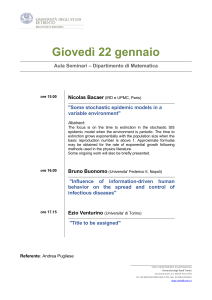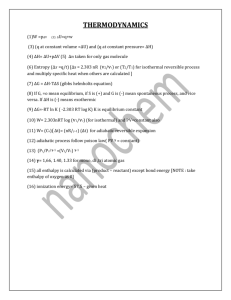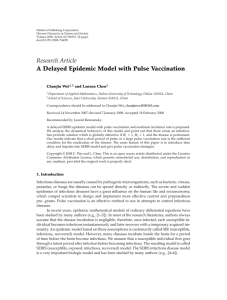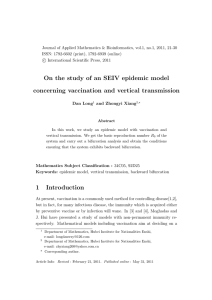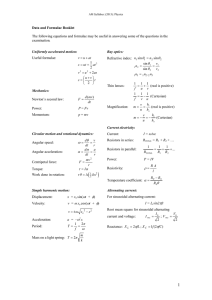The dynamic of a SIV epidemic disease model with Abstract
advertisement
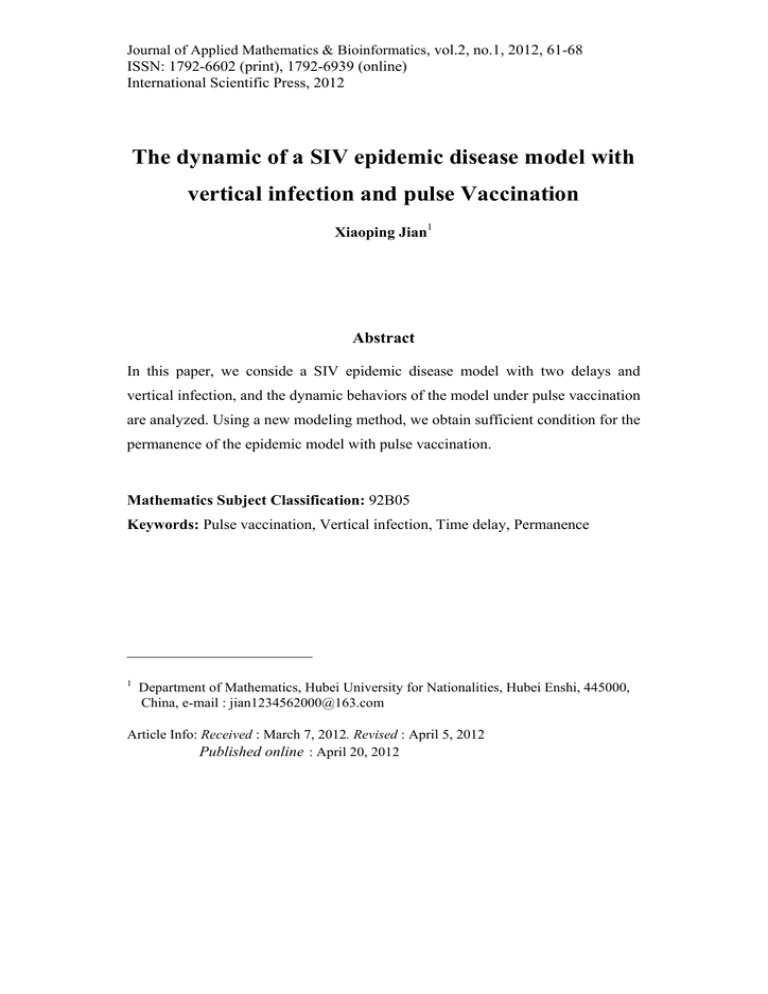
Journal of Applied Mathematics & Bioinformatics, vol.2, no.1, 2012, 61-68
ISSN: 1792-6602 (print), 1792-6939 (online)
International Scientific Press, 2012
The dynamic of a SIV epidemic disease model with
vertical infection and pulse Vaccination
Xiaoping Jian1
Abstract
In this paper, we conside a SIV epidemic disease model with two delays and
vertical infection, and the dynamic behaviors of the model under pulse vaccination
are analyzed. Using a new modeling method, we obtain sufficient condition for the
permanence of the epidemic model with pulse vaccination.
Mathematics Subject Classification: 92B05
Keywords: Pulse vaccination, Vertical infection, Time delay, Permanence
1
Department of Mathematics, Hubei University for Nationalities, Hubei Enshi, 445000,
China, e-mail : jian1234562000@163.com
Article Info: Received : March 7, 2012. Revised : April 5, 2012
Published online : April 20, 2012
62
1
The dynamic of a SIV epidemic disease model ...
Introduction
Many infectious diseases in nature transmit through both horizontal and
vertical modes [2, 3]. These diseases include such human diseases as rubella,
herpes simplex Hepatitis B, AIDS, and so on. For human and animal diseases,
horizontal transmission typically occur through direct or indirect physical contact
with infectious host, or through disease vector such as mosquitoes, tick, or other
biting insects. Vertical transmission can be accomplished through transplacental
transfer of disease agents. Busenberg and Cooke [1] discussed a variety of
diseases that transmit both vertically and horizontally and gave a comprehensive
survey of the formulation and the mathematical analysis of compartment models
that incorporate vertical transmission. In our paper, we assume a fraction of the
offspring of infected hosts is infected at birth, and hence the infected birth flux
will enter class I . Besides a susceptible individual goes through an infectious
period. Since time delay has important biologic meaning in epidemic models.
Therefore, in our paper, we consider two time delays, that is, the number of
the susceptible individuals during an infectious period and temporary immunity
period should be considered, denoted by , , respectively. Now we create a new
delay SIV epidemic model with vertical infection, pulse vaccination into epidemic
model and to obtain some important qualitative properties with delays and valid
pulse vaccination strategy.
2 Main Results
In the following, we consider the SIV epidemic model with vaccination.
Xiaoping Jian
63
dS
S (t ) I (t )
bS ,
dt (1 )(bN pbI ) I V
N
dI pbI S (t ) I (t ) V (t ) I (t ) (b ) I , t nT ,
dt
N
N
dV
V (t ) I (t )
(bN pbI )
(b )V ,
N
dt
S (t ) (1 ) S (t ),
I (t ) I (t ),
t nT .
V (t ) V (t ) S (t ),
(1)
Since the natural birth rate and death rate are the same and the disease is assumed
not to inflict death on the infected host, so the total population is constant, without
loss of generality, let N (t ) 1 , thus, the system (1) can be reduced as following:
dS
dt (1 )(b pbI ) I V S (t ) I (t ) bS ,
dI pbI S (t ) I (t ) V (t ) I (t ) (b ) I , t nT ,
dt
dV
(b pbI ) V (t ) I (t ) (b )V ,
dt
S (t ) (1 ) S (t ),
I (t ) I (t ),
t nT .
V (t ) V (t ) S (t ),
(2)
Since V (t ) 1 S (t ) I (t ), therefore we may just discuss S (t ), I (t ) . Let
Ch { 1 ( s ) 2 ( s ) Ch :
i (0) 0} ,
where i is positive, bounded and continuous function for s s [ , 0] ,
where max , .
Denote
R2
where
(b )T
((1 )b )(1 )(1 e
)
,
(b )T
(b )[1 (1 )e
]
m 2*
(1 )b ( R2 1) ,
(1 ) pb R2
64
The dynamic of a SIV epidemic disease model ...
(1 p)b
.
Theorem 2.1 Suppose (1 p)b 0. If R2 1 , then there exists a
positive constant m2 such that I (t ) m2 for t large enough.
Proof: Suppose that x(t ) ( S (t ), I (t )) is any positive solution of system (2).
The second equation of system (2) may be rewritten as follow:
dI
S (t ) I (t ) (b pb V (t )) I (t ) .
dt
Define
R (t ) I (t )
t
S ( )I ( ) d
(3)
t
calculating the derivative of R(t ) along the solution (2), it follows from (3)
dR(t ) dI (t )
S (t ) I (t ) S (t ) I (t )
dt
dt
( (1 p )b )(S (t ) 1) I (t ).
(4)
since R2 1 , then m2* 0 and there exists a positive constant 1 small enough
such that 1. Where
(1 )(b pbm2* ) (1 m2* ) m2*
[1
] 1 0,
b
1 (1 ) exp((b )T )
for any positive constant t0 , we claim that the inequality I (t ) m2* can not hold
for t t0 otherwise, there is a positive constant t0 , such that I (t ) m2* for all
t t0 . From the first and the fourth equations of system (2), we have
dS
*
*
*
(1 )(b pbm2 ) (1 m2 ) m2 (b ) S , t nT , n N .
dt
S (t ) (1 ) S (t ),
t nT , n N .
we know that there exists such
T1 t0 for t T1 , that
(5)
Xiaoping Jian
65
S (t )
(1 )(b pbm2* ) (1 m2* ) m2*
[1
] 1
b
1 (1 )exp((b )T )
(6)
We have that S (t ) for t T1 .
By (4) and (6), we see that
dR(t )
( (1 p)b )( 1) I (t ),
dt
t T1.
(7)
Let
Il
min
I (t )
t T1 , T1
We show that I (t ) I l for all t T1 , otherwise, there exists a nonnegative
constant T2 such that I (t ) I l for t [T1 , T1 T2 ], I (T1 T2 ) I l and
dI (T1 T2 )
0. Thus from the second equation of (2), (4) and (7), we easily see
dt
that
dI (T1 T2 )
( b pb )( 1) I l 0.
dt
This contradiction. Hence, we get that I (t ) I l >0, for all t T1 .
From (7), we have
dR(t )
( b pb )( 1) I l 0,
dt
This implies R(t ) as t . This is a contradiction to R(t ) 1 for
t large enough. Therefore, for any positive constant t0 , the inequality I (t ) m2*
can not hold for all t t0 .
On the other hand, if I (t ) m2* holds true for all t large enough, then our aim is
obtained. On the other hand, I (t ) is oscillatory about m2* .
where,
66
The dynamic of a SIV epidemic disease model ...
m2 min{
m2*
( b pb)
, m2*e
}.
2
Critical values of some parameters of systems (2) ( R2 1 must be satisfied). The
condition for the permanence of epidemicdisease
(b )T
(b )e
, 1
(b )T
1) (b )
((1 )b ) (e
*
*
T T *, T *
1
(b )
In 1
b ((1 )b )(1 ) (b )
In the following, we shall show that I (t ) m2 . There exists two positive constant
t , such that I (t ) I (t ) m2* , and I (t ) m2* for t t t . When t is
large enough, the inequality S (t ) holds true for t t t , since I (t ) is
continuous and ultimately bounded and is not effected by impulses. We conclude
that I (t ) is uniformly continuous.
Hence there exists a constant T3 (with 0 T3 and T3 is independent of the
choice of t ) such that I (t )
m2*
m*
I (t ) 2 for all t t t T3 . If T3 , our
2
2
aim is obtained.
If T3 , from the second equation of system (2) we have that
dI (t )
( b pb) I (t ) for t t t .
dt
Then we have
I (t ) m2* e
( b pb) , for t t t t .
Since I (t ) m2* , it is obvious that I (t ) m2* for t t t . If , then we
have that I (t ) m2 for t t t . The same argument can be continued, we
can obtain I (t ) m2 , for t t t . Since the interval [t , t ] is
Xiaoping Jian
67
arbitrarily chosen, we get that I (t ) m2 for t large enough. In view of our
arguments above, the choice of m2 is independent of the positive solution of
system (2) which satisfies that I (t ) m2 for sufficiently large t . This completes
the proof.
Theorem 2.2 If R2 >1, then system (2) is uniformly permanent.
Proof: Suppose that X (t ) ( S (t ), I (t )) is any positive solution of system (2) with
initial conditions (3). From the first and the fourth equations of (2), we have that
dS
dt b(1 )(1 p ) (b ) S , t nT , n N .
S (t ) (1 ) S (t ),
t nT , n N .
(8)
we can get such t large enough and 0 small enough that
S (t )
Set
(1 )(b pb) (1 )(1 e(b )T ) m , for t T .
4
1
b
(b )T
1 (1 )e
D {( S , I ) R 2 : m1 S (t ) 1,
m2 I (t ) 1}. Then
D
is a bounded
compact region in which has positive distance from coordinate hyperplanes. One
obtains that every solution of system (2) eventually enters and remains in the
region D . The proof is completed.
References
[1] S. Busenberg and K. Cooke, Vertically Transmitted Disease, Model and
Dynamics, Biomathematical, 23, Springer-Verlag, Berlin, 1993.
[2] Z. Lu, X. Chi and L. Chen, The effect of constant and pulse vaccination on
sir epidemic model with horizontal and vertical transmission, Math. Comput.
Model, 36, (2002), 1039-1105.
68
The dynamic of a SIV epidemic disease model ...
[3] W. Wang, Global behavior of an SEIR epidemic model with two delays,
Appl.Math.Biol., 35, (1996), 240-260.
